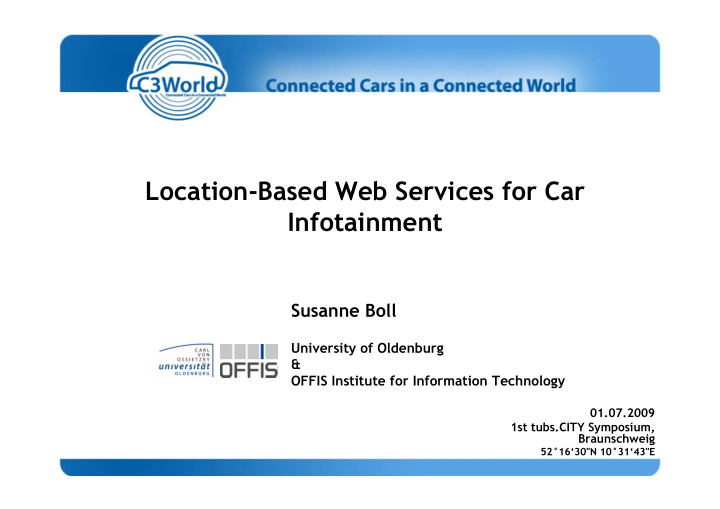



Location-Based Web Services for Car Infotainment Susanne Boll University of Oldenburg & OFFIS Institute for Information Technology 01.07.2009 1st tubs.CITY Symposium, Braunschweig 52°16‘30"N 10°31‘43"E
C3World projekt partners Niedersächsisches Ministerium für Wissenschaft und Kultur OFFIS Oldenburg - Institut für Informatik Technische Universität Carolo Wilhelmina zu Braunschweig Leibniz Universität Hannover Volkswagen Konzernforschung
Overview Analysis of Web Grounding and In-Car Usage Content Mapping of Location and Content Content and External Sources, Navigation and Location Maps, Indexes Infotainment
Motivation Location-related information need • • Users require location-related information • Up to 20% location-related queries at general search engines Spatial information on the Web • • Estimated location references in up to 20% of Web pages • Richer information than most commercial databases • Valuable source of location-based information
Geographic Web Information Retrieval Matching of Web information • to the real world Semantic retrieval of location • information Identification, extraction and • processing of geographic references
The challenge Harvesting, identifying, grounding, • augmenting, exploiting, visualizing location information Geospatial information on the Web is: • Hidden in Web pages • • Metadata: Geographic coordinates • Content: Addresses, Place names Scattered • <META name="geo.position" • Present in a variety of different non- content="53.1467;8.2154"> connected pages Not explicitly structured • • Mostly written in the textual content with typos, omission etc. without known relation to content
Geospatial Web Search Discovery, extraction, processing • of location references Classification of location-relevant • content Semantic enrichment of location • and content Coordinate: 53.146712 ° N 8.215467 ° E Hybrid search on geospatial, • textual and further semantic aspects
Geospatial Retrieval Processes mining scope analysis identification understand geoparsing semantic enrichment link analysis discover augment location crawling extension feedback integration explore visualization annotation interaction
Spatial search as new application for in-car infotainment Understanding of spatial • characteristics Efficient geospatial search engine • In-car Search • • Special (mobile) requirements and information needs • Information for the here and now Development towards integrated • high-value services
Requirements of car-based search Crawling, indexing and querying of Web • understand content Location- and route-specific content • discover augment Information for drivers and passengers • Search interaction • explore Spontaneous and ‚standing‘ search • Visualization within the car systems • Preprocessing and presentation • Integration • Communication of car and search engine • Context processing • Connection to car and navigation systems •
Architecture Search Engine In-Car System Webcrawler, Indexer, Geoparser Presentation, Spatial Web Index Visualization, Interaction Context Preprocessing, Query Engine Context Processing Car-To-X
Context in the car In-Car Context Automotive Context Context for improvement of search results • and situation-aware presentation Adaptation to situation and information need • Spatial context Spatial Context • Position, route, destination,… • Additional context available in the car • CanBUS • Duration of trip • User Context User profile • Familiarity with route • Type of trip • … •
Spatial context is more than position Route estimation, departure, • destination, speed, time, distances, … Support of mobile users‘ • information needs Result adaptation in mobile IR • Spatial Query + Spatial Filters + • Spatial Ranking � Spatial Search Hybrid search: combination of • spatial and textual features
Interface and Presentation • Challenges Restricted interaction • Restricted attention • Fast mobile movement • • User interaction Intuitive query formulation and • handling Use of rich context information • Dynamic interaction and exploration • • Presentation of content Preprocessing and adaptive • visualization Use of semantic aspects to match query • and content
Conclusion Spatial search as new application for • in-car infotainment Spatial search engines for trip-based • and roadside information Navigation as ‚smart passenger‘ • Research challenges in • • Web search • Geographic information retrieval • HMI • Automotive Infotainment
Q&A Susanne Boll Media Informatics and Multimedia Systems University of Oldenburg, Oldenburg, Germany susanne.boll@informatik.uni-oldenburg.de 53° 8 ′ 55.9 ″ N 8° 12 ′ 0.43 ″ E
Recommend
More recommend